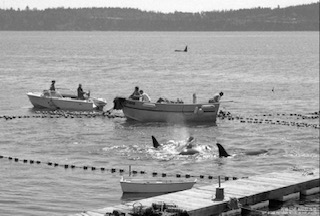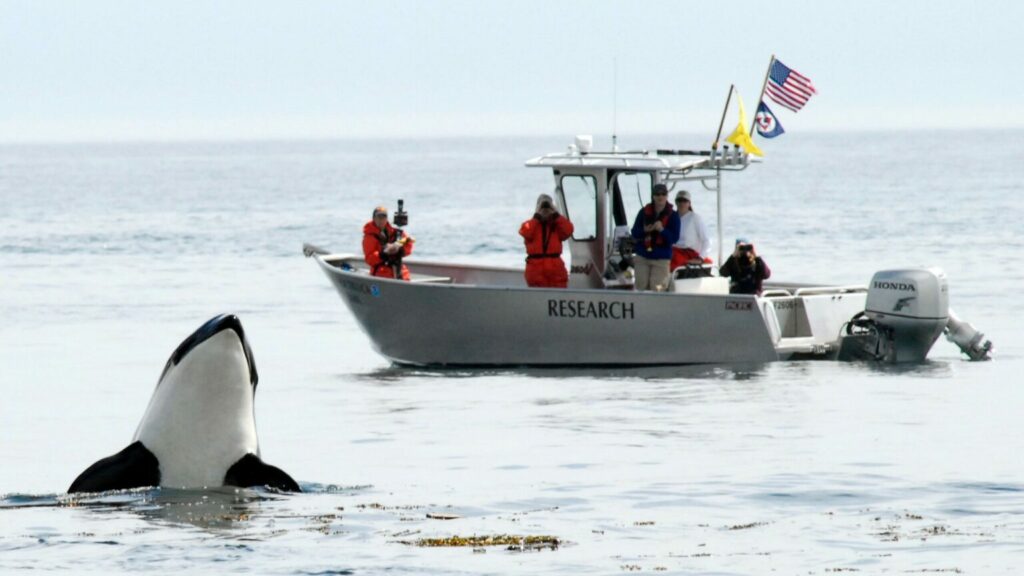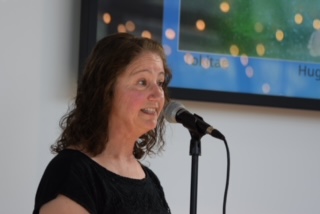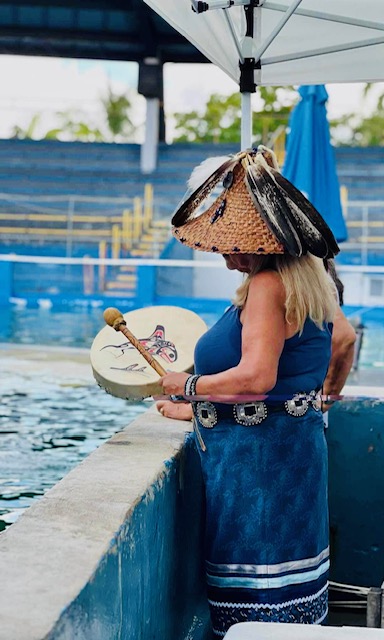Opinion Advocates for ideas and draws conclusions based on the author/producer’s interpretation of facts and data.
Calling Tokitae Home

Salmon are thought to remember the smell of their home streams. When ready to spawn, they often travel thousands of miles through the ocean, then upriver against the current, flinging themselves up rapids and falls, all in a relentless drive to return to the stream where they were born. Both life and death come together at the spawning ground, as one generation is born and another dies.
The Lummi, a Coast Salish tribe located just south of the Canadian border in Washington state, believe the smell of cedar guides the salmon to the streams of their birth to spawn. These powerful trees cast out a lifeline of fragrance into the water that pulls and tugs the salmon home.
Now this powerful cedar spirit calls home a different aquatic relative, one who recently died in captivity: a killer whale, or orca, known to audiences at Miami’s Seaquarium as Lolita, to animal activists all over the world as Tokitae, and to the Lummi Nation as Sk’aliCh’elh-tenaut (SKAH-lee-CHUK-tah-NOT).
I have to confess, at first I didn’t think much of all the people I saw on social media mourning the death of Sk’aliCh’elh-tenaut, which occurred at the Seaquarium on August 18. I thought there were much more important things Native people needed to worry about than mourning a dead whale.
I realize now I just didn’t want to think about Sk’aliCh’elh-tenaut. It was overwhelming to consider her death after having spent 53 years confined in an 80-by-35-foot tank. It gave me vertigo. I recoiled from the subject and even made fun of it. But like the smell of cedar, something pulled and tugged at my heart, calling me to learn more.
She Is Our Relative
“We consider all orcas our relatives that live under the water,” Lummi elder and vice president of Sacred Lands Conservancy Raynell Morris told me. “Our name for them is qwe’lhol’mechen.”
Traditionally, Native people feel all things are related. The well-known Lakota phrase “Mitakuye Oyasin” is most commonly translated as “All my relations,” or “We are all related.”
I never thought about this concept too deeply. It seemed like a nice sentiment, but that’s all. Then Raynell told me a personal story about her interaction with Sk’aliCh’elh-tenaut in Miami that raised my understanding of the phrase to a higher level.
I listened, slowly realizing her connection to Sk’aliCh’elh-tenaut had profound meaning. Her story illuminated the subtle web of energy that underpins the world of the Lummi and in fact of all Native people. With Raynell’s permission, I’m recording it here.

The Theft of Baby Toki
To appreciate Raynell’s story, it’s important to know a little background. A week before my interview with Raynell, I attended a memorial in Tacoma for Sk’aliCh’elh-tenaut, known to her human friends as Toki, short for Tokitae, an old Chinook name given to her after she was first captured.
I learned Toki was taken on August 8, 1970, from Penn Cove off Whidbey Island. She was a member of L-pod, a family of southern resident killer whales in Puget Sound. The current matriarch of that pod, a female thought to be more than 90 years old named L-25 or Ocean Sun, is thought to be either Toki’s mother or aunt. Toki was a princess.
Toki was one of nearly 300 young orcas who were captured in Puget Sound between 1962 and 1976, a practice that generated tremendous public outcry, eventually outlawed by the office of then Gov. Dan Evans.
The brutal hunting process used helicopters to locate orca pods. Hunters in boats then dropped M-80 explosives into the water to separate the adults from the children.

During the hunt on that day in 1970, four baby orcas and one adult drowned, and seven young orcas, Toki among them, were stolen from their families. Toki is said to have been about 4 to 6 years old, but judging from her size in photos taken at the time, marine biologists currently think she was more like 1½ or 2.
According to eyewitnesses, the adult orcas refused to leave, screaming and crying outside the netted area where the young ones had been caught. They watched as Toki was hoisted up out of the water in a sling.
The hunters hauled her away on a flatbed truck, the haunting cries of her orca family fading in the distance. Before long, Toki would be in an undersized “whale bowl” at the Miami Seaquarium. As an adult she grew to 22 feet long, performing up to three shows a day, never leaving that small tank until her death in August—53 years later.

They’re Just Like Native People
Toki belongs to a special group of orcas who have lived in the Salish Sea, which includes Puget Sound, for as long as 18,000 years, according to marine biologist Deborah Giles.
“Most orcas travel freely throughout the ocean, but there are about 15 resident groups who remain local to certain areas in different parts of the world,” Giles explains. “The southern residents have been studied the longest, since 1973.”
They’re called southern resident killer whales because they stay within a relatively small area from the waters off Northern California up to Haida Gwaii in Canada. Unlike other orcas, they don’t eat marine mammals such as seals. Instead, they rely only on fish. No one knows exactly how this special group formed.
“Most likely, part of it had to do with the glaciers that formed and retreated,” Giles tells me. “The animals got physically separated when the glaciers formed.”
Cut off from the mammal-eating orcas, Toki’s ancestors adapted to eating only fish. Then, when the glaciers receded around 18,000 years ago, the orcas’ two new cultural traditions of eating only fish and remaining in one area were pretty much locked in.
Native villages along the shores of Puget Sound also grew up around this time, and tribes there, such as the Lummi, saw the orcas and felt a strong kinship with them. The social structure of the Lummi and the orcas are similar.
Both groups form clans. The southern resident orcas are members of one clan who all speak the same orca language, separate from the language of other clans. Within the clan, smaller family groups called pods exist, each with slightly different dialects of this language—the same as with Native tribes.
Southern residents are matriarchal. They are run by powerful females. This is similar to the matrilineal nature of Coast Salish tribes. Each whale pod has a matriarch who, with a slap of her tail on the water’s surface, can immediately summon all pod members.

The most moving similarity, however, is how emotionally close orcas are to each other.
“That’s part of what makes them so amazing,” Giles says, “their close, close, tight family bonds and how committed they are to one another. They socially hunt and they share food, literally grabbing a fish, biting it in half, and then sharing it with another family member.”
Giles has even witnessed adult orcas playing with babies by tossing them up in the air the way a proud human daddy or grandma might do. The orca babies seem to love it as much as human babies do.
The sharing of these and many other traits between the Lummi and the southern resident orcas is more than just a coincidence. It is evidence of the permeability between the Lummi world and the orca world, in which there is a blending of the two, a sharing of identities, and a recognition of each other as relatives: Mitakuye Oyasin.

Calling Toki Home
After learning about Toki and her tribe, I was primed to hear Raynell’s story. She and another Lummi elder, Ellie Kinley, had been regularly traveling more than 3,300 miles from Washington state to Florida to visit Toki at the Seaquarium.
For about 14 months they made regular visits, drumming, singing, and praying for Toki outside the entrance to her tank. Eventually, the park allowed them inside where Toki could see and hear them. They always brought cedar boughs and wreaths to leave, hoping Toki would remember the smell.
At the end of June, Raynell sang and drummed for Toki at the water’s edge. She brushed Toki with a cedar bough when she came close. Raynell believes her drumming carried a private message from Toki’s ancestors. She says Toki listened intently to the orca words hidden within the drumbeat and at one point she danced to it, spun around, and splashed Raynell.
“Water was dripping from my cedar hat. I mean, she did that on purpose, right?”
Whether Toki was just being playful, or celebrating that her ancestors had secretly told her she would soon be coming home, no one can say for sure.
A month and a half later, after a sudden, unexpected illness, Toki passed into the spirit world.
“When I got the call that she had passed, I said, ‘I’m coming! I’ll be there tomorrow,’” Raynell recalls.
On the flight to Miami, Raynell became ill with pain so bad that she was admitted to Mercy Hospital and underwent emergency surgery. Her symptoms mirrored Toki’s.
“She had lung lesions and abdominal issues. I had a partially collapsed lung and also had abdominal surgery,” she remembers.
While recuperating in the hospital, Raynell looked up one day and saw the sun rise.
“That particular day I was longing for her, and I called out her name three times.”
In the radiant light of dawn, Raynell saw a vision of Toki, Sk’aliCh’elh-tenaut, appearing in the sun.
“All around her were whale people and ancestors from the other side surrounding her, and they’re telling me, ‘We have her.’”
On the day of Toki’s death, her family appeared in Puget Sound. Only one among them had been alive when Toki was stolen, L-25, Ocean Sun, now in her 90s and thought to be Toki’s mom.
It was clear the gathering was welcoming Toki’s spirit back to her ancestral waters.

Toki’s Teaching
Learning about Toki and hearing Raynell’s story woke up memories of my own. I, too, had been taken from my homeland when I was a toddler.
My family moved from beautiful Juneau, Alaska, to noisy, crowded Seattle in 1960, when I was almost 3 years old. I was too young to understand what was going on at the time, and thought my mom and dad were punishing me for being bad. They took Juneau away from me, I thought, and I secretly hated them for it. I didn’t understand they had wounds of their own and were trying to save me from a similar fate.
That’s why I didn’t want to think about Toki when I first heard she died. All the anger I’d held inside my whole life about my own separation from Juneau and my mother’s culture threatened to explode as it had when I was a young man. That anger had previously led to drug abuse, crime, and even prison. I wasn’t about to let that happen again. That’s why I initially recoiled.
Toki’s death and life opened a door for me as it has for many others. It showed me how to heal intergenerational trauma. We must reconnect with our past and find out who we are. We must reconnect with our homelands. We must find our families and, if necessary, forgive them.
I am just one of many who’ve been taught by Toki. Native people have suffered separation for generations due to things like compulsory boarding schools, forced relocation, and the theft of our lands.
Toki never made it home physically. However, after hearing Raynell’s story I am convinced part of her never left. The web of life never completely separated her from her family. Those bonds are stronger than the nets that caught her. They freed her with the sound of the drum and the smell of cedar.

|
Frank Hopper
, Tlingit, is a freelance Native journalist born in Juneau, Alaska, now living in Tacoma, Washington. His work appears in Last Real Indians, The Stranger, and Indian Country Today. His self-titled YouTube channel features videos about Native issues. He can be reached at [email protected].
|







